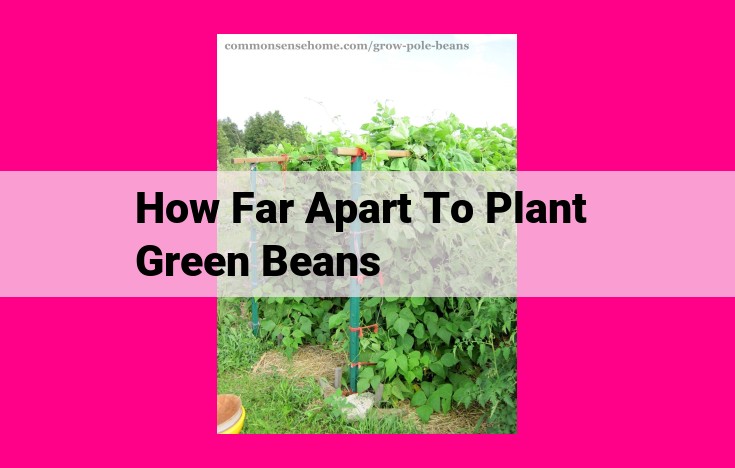Maximize Green Bean Productivity: Spacing, Trellising, And Companion Planting

To optimize green bean spacing, sow seeds 2-3 inches apart in rows spaced 24-36 inches to promote uniform growth and yield. Trellising enhances sunlight exposure, reduces pests, and increases production. Companion planting with insect-attracting or pest-deterring plants can further enhance growth by improving soil health and ecology.
Optimal Seed and Row Spacing for Maximum Yield
The Importance of Optimal Seed Spacing
Optimal seed spacing is crucial for maximizing crop yield and ensuring uniform plant growth. Proper spacing allows plants to access essential resources such as sunlight, water, and nutrients without excessive competition. When plants are too closely spaced, they compete for these resources, resulting in stunted growth, reduced yields, and increased susceptibility to diseases.
The Impact of Row Spacing
Row spacing, along with seed spacing, plays a significant role in overall crop productivity. Wider row spacing allows for better air circulation, reducing disease pressure and improving sprayer penetration. It also facilitates mechanical operations like cultivation and harvesting. However, narrower row spacing can increase yield potential by maximizing plant density. The optimal row spacing depends on crop type, plant habit, and environmental conditions.
Trellising: A Support System for Vine Crops
For vine crops, a trellis is a game-changer. Not only does it provide essential support, but it also unlocks a wealth of benefits that will take your harvest to the next level.
Improved Sunlight Exposure: Vines naturally reach upwards, seeking sunlight for their leafy growth and fruit production. A trellis gives them the means to do just that, allowing them to spread out and maximize their exposure to the sun’s rays. The result? More photosynthesis, which translates into more energy for growth and fruit development.
Reduced Pests: Pests thrive in shady, moist environments. By raising vines off the ground, you create a dryer, less hospitable space for these unwanted visitors. Additionally, the open structure of a trellis allows for better air circulation, which further discourages many common vine pests.
Increased Yield: With ample sunlight and reduced pest pressure, your vines have a clear path to optimal health and productivity. A sturdy trellis provides the support they need to bear the weight of heavy crops, preventing breakage and ensuring maximum yield.
Common Trellising Systems
The type of trellis you choose will depend on the specific vine variety you’re growing. Here are some common systems:
-
Vertical Cordon Trellis: Vertical posts support horizontal wires, creating a grid-like structure. Suitable for grapes, hops, and other vigorous vines.
-
T-Trellis: Similar to a vertical cordon trellis, but with a horizontal crossbar at the top. Ideal for tomatoes, beans, and cucumbers.
-
Espalier: Vines are trained to grow flat against a wall or fence. Suitable for fruit trees, grapes, and espaliered tomatoes.
-
Arbor: A freestanding structure that creates a shaded area for climbing vines. Perfect for grapes, clematis, and roses.
Benefits for Specific Vine Types
-
Grapes: Trellising improves sunlight exposure and air circulation, leading to higher grape yields and reduced disease.
-
Tomatoes: Trellising supports heavy tomato plants, preventing breakage and enhancing fruit quality. It also promotes better airflow, reducing susceptibility to diseases like blight.
-
Cucumbers: Trellising cucumbers keeps the fruits off the ground, improving their appearance and preventing rot. It also makes harvesting easier.
Embrace the power of trellising for your vine crops. From improved sunlight exposure and reduced pests to increased yield, it’s a simple yet transformative solution that will elevate your gardening experience and reap the rewards of a bountiful harvest.
Companion Planting: Harnessing the Power of Plant Synergies
Imagine a thriving garden where plants cohabitate harmoniously, enhancing each other’s growth and productivity. This magical world is brought to life through the art of companion planting, a sustainable gardening technique that harnesses the remarkable synergies between different plant species.
Companion Planting Benefits:
Attracting Beneficial Insects:
Certain plants, like marigolds and cosmos, emit scents that attract beneficial insects to your garden. These insects prey on pests and help maintain a healthy ecosystem.
Improving Soil Health:
Legumes, such as beans and peas, have the remarkable ability to fix nitrogen in the soil. This nutrient-rich nitrogen becomes available to neighboring plants, fostering their growth.
Detering Pests:
Some plants act as natural pest repellents. For instance, garlic and onions release pungent odors that discourage pests like aphids and thrips.
Compatible Companion Plant Combinations:
Tomatoes and Basil: Basil is a wonderful companion for tomatoes. It releases volatile compounds that repel insects and enhance tomato flavor.
Carrots and Onions: Onions release sulfur compounds that repel carrot root flies. In turn, carrots improve onion growth by aerating the soil.
Cucumbers and Marigolds: Marigolds attract beneficial insects and repel nematodes, which can harm cucumbers.
Corn and Beans: Corn provides structural support for beans to climb, while beans fix nitrogen for the corn, creating a mutually beneficial relationship.
Companion planting is a powerful tool that transforms your garden into a thriving, interconnected ecosystem. By carefully selecting compatible plant combinations, you can enhance plant growth, improve soil health, deter pests, and create a vibrant, sustainable garden that will delight your senses and nourish you for seasons to come.